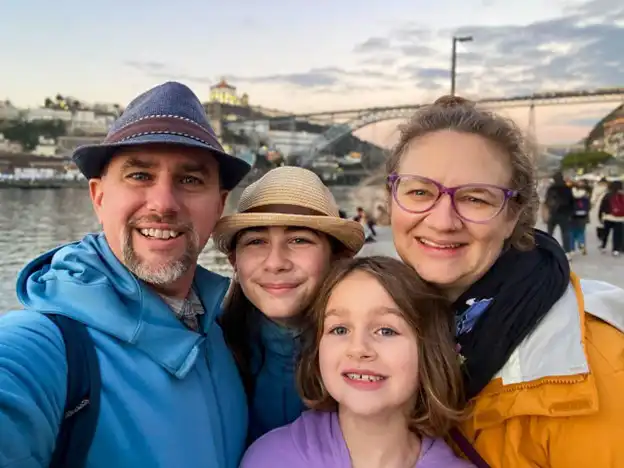by Jodie St. Clair

Listen to this Article
Travelling with a disability means packing a new mindset
The way travel gets discussed is exhausting. Fast-paced trips get showcased with itineraries so overstuffed, you’d swear that in order to do everything you’ll have to get up before you go to bed.
When you add in a disability, those fear-of-missing-out itineraries become all the more demoralizing. I’ve been an above-knee amputee and prosthetic user for nearly thirty years. I’m also a mother of two. Along with my husband, we’ve been traveling the world full time with our kids for over two years. Instead of getting burned out, we stay fired up about travel, in part because of the things we’ve learned both from being parents and from making sure our travels work for me and my disability.

Slow down
People speed through trips because vacation time isshort, and they don’t want to miss out. However, this is why people come home saying “I need a vacation from my vacation.”
A person with a disability expends more energy and tires more easily. A slower pace has made our travel days enjoyable instead of exhausting.
Skip trying to do everything, set priorities, and let the rest slide
Our travels and vacations improved when we stopped trying to “do everything” in a destination.
Now, we set three must-do top priorities, based on what matters to us as a family. We’ll set secondary goals too, but they are “might do” not “must do” things. If something doesn’t appeal to us, even if it’s what a destination is known for, we skip it.
Build in downtime
As parents, we don’t want our kids to miss anything (nor do we want to forget something important, whether that’s an activity or the toothbrush charger).
However, downtime is critical, especially for kids and for people who have disabilities. We check in on our energy levels, and we balance a big activity day with downtime later or the following day. Not only can we reflect on our experiences, we recharge and can resume our activities with excitement.

Use itineraries as inspiration, not checklists
Itineraries help us cluster activities and set priorities. However, most suggested itineraries are aspirational, best-case scenarios. They don’t account for a big bout of phantom limb in an amputee, or a need to take an unscheduled snack or beverage break so you can rest.
Our destination research pulls up loads of ideas and itineraries. We only use them for inspiration, not as checklists.
You don’t have to hide your disability
Disabilities can be invisible or apparent, but some can be concealed. If I wear pants, for example, my prosthetic leg is less noticeable than when I wear a dress or a skirt. In our experience, my disability being visible and apparent has led to conversations with locals, not to mention kindnesses and consideration from strangers.
Accessible recreational spaces make it easier to enjoy playgrounds, trails, and more
When a travel or recreation space is designed for accessibility, it can be easier to access for adults with disabilities too. When we hike in the USA, we often seek out ADA trails, as they’ve been designed with Americans with Disabilities Act standards in mind.
At accessible playgrounds I can be far more present and engaged with my kids, since the space is usually easier for me to navigate.
Ask for (and accept) help
On public transportation in many countries, if my prosthesis is visible, people usually ask if I want to sit down.
Adults traveling with kids and/or a visible disability often learn that help is out there. When we arrive in a new country, for example, we find an immigration official and make them aware that we are traveling with kids, and that I have a disability. Often we get transferred to a (usually shorter) line for families and for people with special needs.
People often want to be kind and helpful. I’ve learned not only to be okay with accepting help from others, but to be willing to ask.
Our slow travels are easier, joyful, and more fun
Our slow travel mindset and focus on our vacation priorities has made all the difference for our family of four, and for me as a traveler who has a disability.
No matter your ability or disability, travel has challenges. When you shift your travels to the right gear for you, not only can you leave FOMO at home, your trip can bring you better experiences and lasting memories.
About Jodie, Anthony, Connor, and Aster St. Clair: We are the Learners and Makers, and we empower families and the mobility disability community to travel confidently, their way. Our kids are 12 and 9. Jodie is an above-knee amputee. We love showing our kids as much of the world as we can. We’ve traveled the world full time since 2022.
